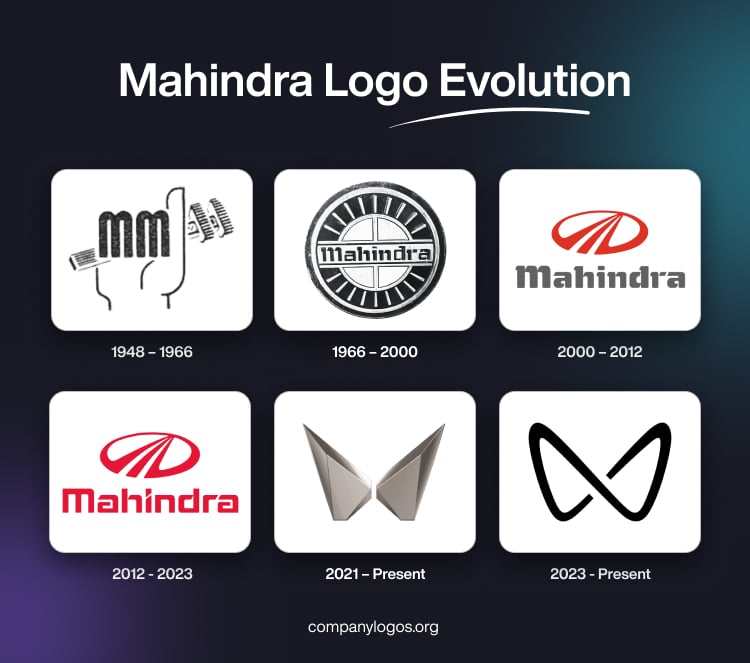
Mahindra is one of India’s most prominent industrial conglomerates. Established in 1945, the company initially was engaged in the production of steel. However, today, the company has diversified into several fields, which include automobiles, IT, defence, agricultural machinery, and hospitality, among others. The SUVs, trucks, and electric vehicles produced by the company are reputed for their ruggedness and reliability.
Mahindra’s rich legacy is reflected in its evolving visual identity as well. The journey of its logo mirrors the brand’s transformation from a steel trader in post-independence India to a global leader in mobility and innovation. The article delves into the evolution of the Mahindra logo over the years, among other details of the company.
The Genesis of the Mahindra Logo (1948 – 1966)
The original Mahindra logo design captured the industrial spirit of the company. It depicted a gear, hand tools, and an “MM” monogram. The clever integration of two “M” letters in lowercase formed the fingers grasping a tool. It was a visual embodiment of craftsmanship, engineering prowess, and a hands-on approach to building the new nation. The logo reflected strength and reliability, qualities dearly valued in India’s formative years.

(1966 – 2000)
As Mahindra expanded its business in the 1960s, its identity evolved to reflect optimism and growth. The new logo introduced in 1966 in monochrome featured a circular black emblem with sunrays in silver to symbolise a new dawn and progress.
The “Mahindra” wordmark in bold title case and rendered using a custom font was placed at the centre of the emblem on a badge. In fact, the logo looked like a steering wheel. This period witnessed Mahindra’s expanding footprint in automobile and tractor manufacturing, and the logo demonstrated increased ambition and a forward-looking vision.

(2000 – 2012)
Entering the new millennium, Mahindra repositioned itself as a modern multinational entity. In 2000, the brand launched its most recognisable logo: a red oval containing a stylised letter “M” depicted through three upward-sloping lines. The red oval signified energy, passion, and progress.
Popularly termed the “Road Ahead,” this design is complemented by a bold grey wordmark in a custom typeface with playful tails and rounded lines. The logo represented speed, motion, and the company’s unwavering ambition. The motif of movement and dynamism was fitting for a brand leading innovation in mobility, technology, and finance.

(2012 – 2023)
In 2012, Mahindra refreshed its logo to underline its global and increasingly tech-driven identity. Designed by Landor, the wordmark “Mahindra” in the logo adopted sharper curves, pronounced diagonal cuts in select letters, and a deeper shade of red. The road motif was retained for its minimalist and strong design.

(2021 – Present)
As Mahindra entered a new era after 2021, the logo underwent its most radical transformation with the introduction of the “Twin Peaks” for its SUV division. This futuristic emblem features two chrome-infused, upward-pointing peaks forming the letter “M” to symbolise freedom, exploration, and next-level strength.
The visual identity aims to evoke a powerful sense of adventure, ambition, and “exploring the impossible.” It perfectly aligned with Mahindra’s positioning as a leader in innovation and adventure-ready vehicles. Interestingly, the wordmark “Mahindra” was removed from the logo.

(2023 – Present)
Designed by Pratap Bose, the latest logo iteration has been designed for the electric vehicles produced by the company. This logo with a minimalist and modern design features two symmetrical arcs in black joining at the middle to form an abstract letter “M.” The logo sports a sleek and contemporary look and represents the values of simplicity and clarity embodied by the company.

The Elements of the Mahindra Logo
Font
The Mahindra logo employs a custom rustic typeface to depict its visual identity for a long time. However, the latest logo iteration does not find mention of the wordmark.
Colour
The colour palette used to design the Mahindra logo comprises yellowish silver to evoke a sense of quality and excellence. The colour represents the stability and professionalism of the company.
The History of Mahindra
Mahindra was founded in 1945 as Mahindra & Mohammed by brothers Jagdish Chandra (JC) Mahindra, Kailash Chandra (KC) Mahindra, and Malik Ghulam Muhammad in Ludhiana, Punjab. Initially, it operated as a steel trading firm focused on the opportunities generated after the Second World War in India. Thereafter, after the Partition in 1947, Malik Ghulam Muhammad moved to Pakistan, and the company was renamed Mahindra & Mahindra.
That same year, Mahindra ventured into the automobile sector by assembling Willys Jeeps under license, which laid the foundation for its future growth. In 1956, Mahindra & Mahindra became a publicly listed company on the Bombay Stock Exchange, thereby securing capital for further expansion.
During the 1960s and 1970s, the group diversified its operations significantly by entering into a strategic partnership with International Harvester (USA). This partnership led to the manufacture of tractors and collaboration with Ugine Kuhlmann (France) to form Mahindra Ugine Steel Company. It thus strengthened the company’s presence in agricultural machinery and steel production.
The 1980s saw Mahindra emerge as a pioneer in Indian farm mechanisation with rapid production of tractors and farm equipment. Thereafter, the company also forayed into IT and telecom ventures that eventually evolved into Tech Mahindra.
From the 1990s onwards, Mahindra expanded into various sectors, including financial services with Maxi Motors Finance (now Mahindra Finance), hospitality through Club Mahindra, education, and rural empowerment projects like Project Nanhi Kali. In 2002, the launch of the Scorpio SUV, Mahindra’s first indigenously designed vehicle, helped establish its reputation for rugged and locally engineered automobiles. Between 2007 and 2010, Mahindra further expanded globally by acquiring Punjab Tractors (renamed Swaraj) and entering aerospace with Gipps Aero (Australia). It also acquired Reva Electric Vehicles to enter the electric mobility segment.
In the 2010s, Mahindra adopted the “Mahindra Rise” philosophy as part of its digital and innovative transformation. Consequently, Tech Mahindra became one of India’s leading IT firms. The group revived iconic motorcycle brands like Jawa through its subsidiary Classic Legends in 2018 and demonstrated advanced technology leadership in 2019 with the launch of the Pininfarina Battista, the world’s first all-electric hypercar.
More recently, Mahindra has introduced popular vehicles such as the new Thar, XUV700, and Scorpio-N. At the same time, it expanded its global footprint to over 100 countries and established itself as a leader across diverse industries. These include SUVs, tractors, electric vehicles, aerospace, agribusiness, IT, finance, real estate, and renewable energy.
Mahindra stands as one of India’s largest conglomerates with more than 250,000 employees, a strong global presence, and an enduring commitment to sustainability and community empowerment. This reflects the company’s remarkable journey and the economic development of modern India.
Interesting Facts About Mahindra
- Mahindra & Mahindra began in 1945 as Mahindra & Mohammed, a steel trading company. It was renamed Mahindra & Mahindra after the partition when Ghulam Mohammed moved to Pakistan. Thereafter, from steel, Mahindra diversified into automobiles, aerospace, IT, finance, and even agriculture.
- In 1947, Mahindra began assembling the Willys Jeep in India under license, which laid the foundation of its long-standing reputation in rugged utility vehicles.
- Mahindra operates in over 100 countries and has a strong presence in North America, Europe, Africa, and Southeast Asia. It owns international brands like
- SsangYong Motor (South Korea)—though sold later
- Peugeot Motorcycles (France)
- Pininfarina (Italy)—the iconic automotive design firm
- Mahindra is the world’s largest manufacturer of tractors in terms of units sold. It has even surpassed John Deere in global volumes.
- Mahindra Aerospace manufactures aircraft parts and small planes, and Mahindra Defence Systems is actively involved in military vehicles, naval systems, and surveillance technologies.
- Mahindra was the first Indian company to commit to carbon neutrality by 2040. Its Igatpuri and Zaheerabad plants are among India’s first carbon-neutral manufacturing facilities.
- Mahindra Racing is one of the founding teams in Formula E, the international all-electric racing series. It was also the first Indian team to participate in an FIA World Championship.
- Mahindra’s IT arm, Tech Mahindra, is a global leader in digital transformation, AI, and telecom services, and one of India’s top 5 IT firms by revenue.
- Club Mahindra is one of India’s most recognised vacation ownership brands, which operates resorts across India and abroad.
- The company was founded by J.C. Mahindra, K.C. Mahindra, and Malik Ghulam Muhammad. Anand Mahindra, the current chairman, has played a key role in turning it into a global powerhouse.
Finally
The evolution of the Mahindra logo is more than a design journey; it is a symbol of India’s industrial rise and a testament to the brand’s agility. Each logo iteration reflects the ambitions, transitions, and unwavering commitment of the company to progress. So, be it the rugged industrial beginnings or the sleek “Twin Peaks” of today, Mahindra’s logos have signalled the brand’s drive to innovate, inspire, and lead.